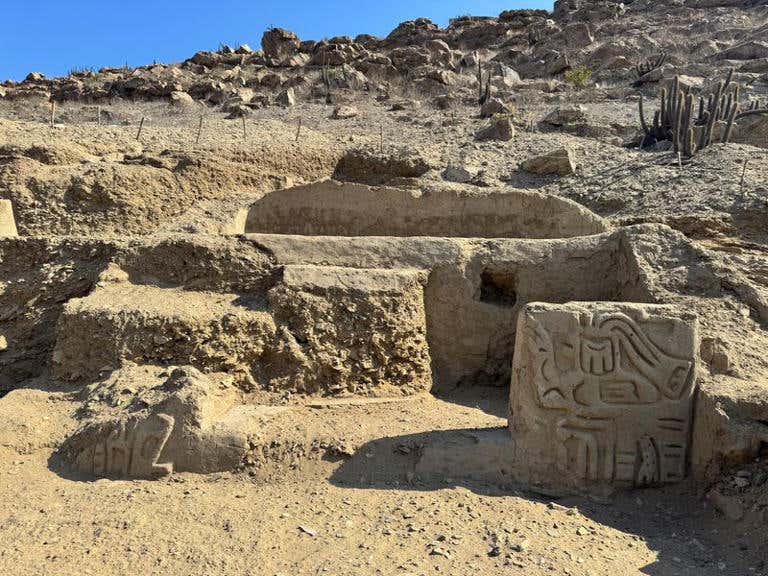Archeologists discover ancient temple in Peru dating back 4,000 years
One temple wall features a high-relief drawing of a mythological figure with a human body and a bird’s head whose design predates the pre-Hispanic Chavin culture.

A team of archaeologists has unearthed the ruins of a 4,000-year-old ceremonial temple buried in a sand dune in northern Peru. (CREDIT: Reuters)
A team of archaeologists has unearthed the ruins of a 4,000-year-old ceremonial temple buried in a sand dune in northern Peru. Alongside the temple, they found skeletal human remains, likely offerings for religious rituals.
The discovery occurred in the Zaña district of the Lambayeque region, a short distance from the Pacific Ocean and approximately 780 km (484 miles) north of Lima, the capital. Zaña, known historically as Çañap in Mochica, is located 25 kilometers (16 miles) inland from the ocean at an elevation of 58 meters (190 feet) in the Zaña River valley.
This area became a major center for sugar cane production and was one of colonial Peru's most important cities. English pirates raided Zaña in 1686, and a flood in 1720 further diminished its significance. The town had a population of 4,510 in 2017.
"We are still waiting for radio-carbon dating to confirm the date, but the evidence suggests this religious construction could be part of a tradition of temples built on Peru's northern coast during that period," said Luis Muro, an archaeologist from Peru's Pontifical Catholic University who led the research.
Muro's team discovered the skeletal remains of three adults between the walls and bases of what was once a multi-story structure. One of these skeletons was accompanied by offerings and possibly wrapped in linen or clothing.
One temple wall features a high-relief drawing of a mythological figure with a human body and a bird's head. Muro noted that this design predates the pre-Hispanic Chavin culture, which thrived on the central Peruvian coast for over half a millennium starting around 900 BC.
In another nearby excavation, Muro's team found remains of what might have been another temple belonging to the late Moche culture, which arose about 1,400 years ago across the northern coast.
Northern Peru is rich with ancient ceremonial complexes. The Sacred City of Caral, about 5,000 years old, stands out in this region. Meanwhile, southern Peru's Ica region is known for the Nazca lines, mysterious geoglyphs carved into the desert more than 1,500 years ago.
Peru's most famous archaeological site is the Incan citadel of Machu Picchu, located in the mountainous Cusco province. This World Heritage site was built in the mid-15th century and remains a testament to the Incan civilization.
Note: Materials provided above by the The Brighter Side of News. Content may be edited for style and length.
Like these kind of feel good stories? Get the Brighter Side of News' newsletter.
Rebecca Shavit
Science & Technology Journalist | Innovation Storyteller
Based in Los Angeles, Rebecca Shavit is a dedicated science and technology journalist who writes for The Brighter Side of News, an online publication committed to highlighting positive and transformative stories from around the world. With a passion for uncovering groundbreaking discoveries and innovations, she brings to light the scientific advancements shaping a better future. Her reporting spans a wide range of topics, from cutting-edge medical breakthroughs and artificial intelligence to green technology and space exploration. With a keen ability to translate complex concepts into engaging and accessible stories, she makes science and innovation relatable to a broad audience.



